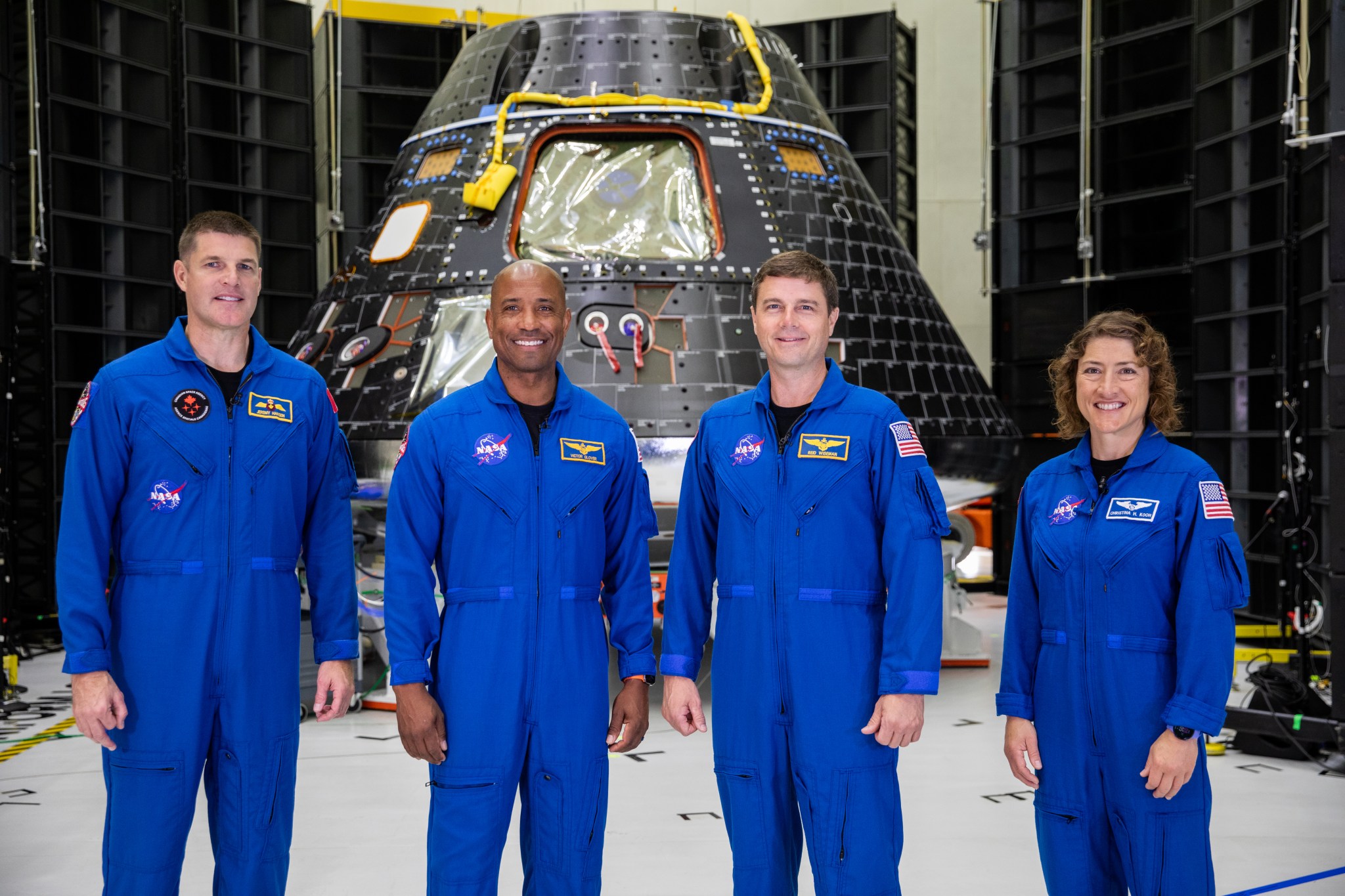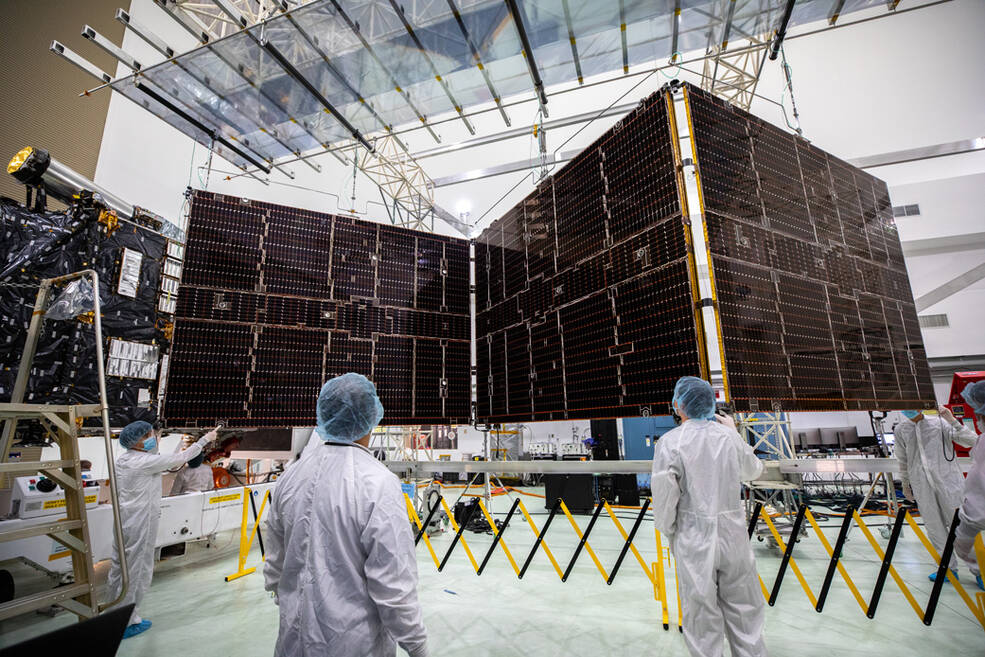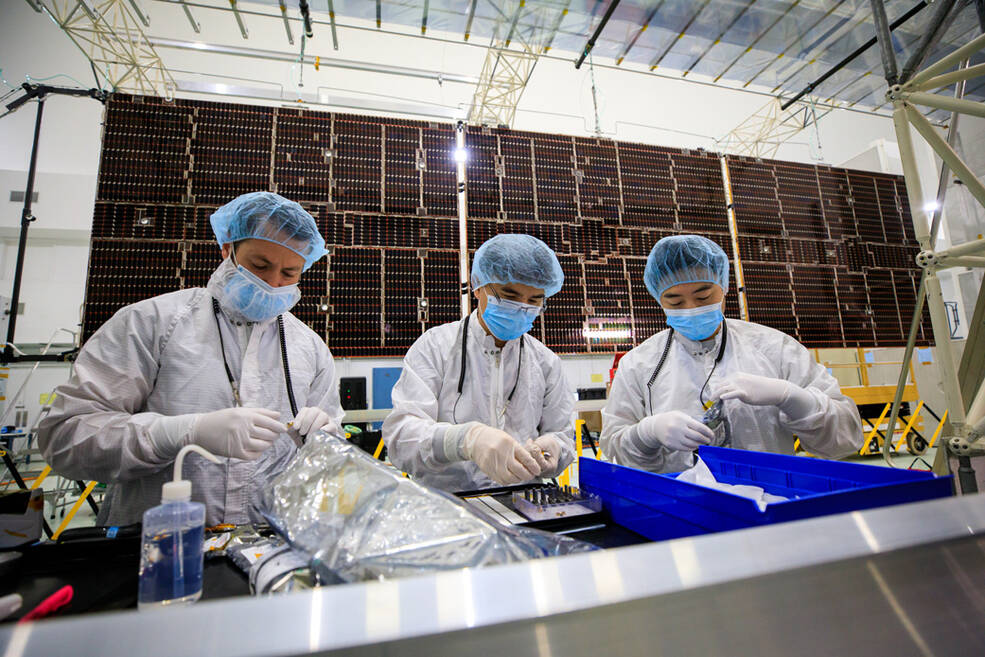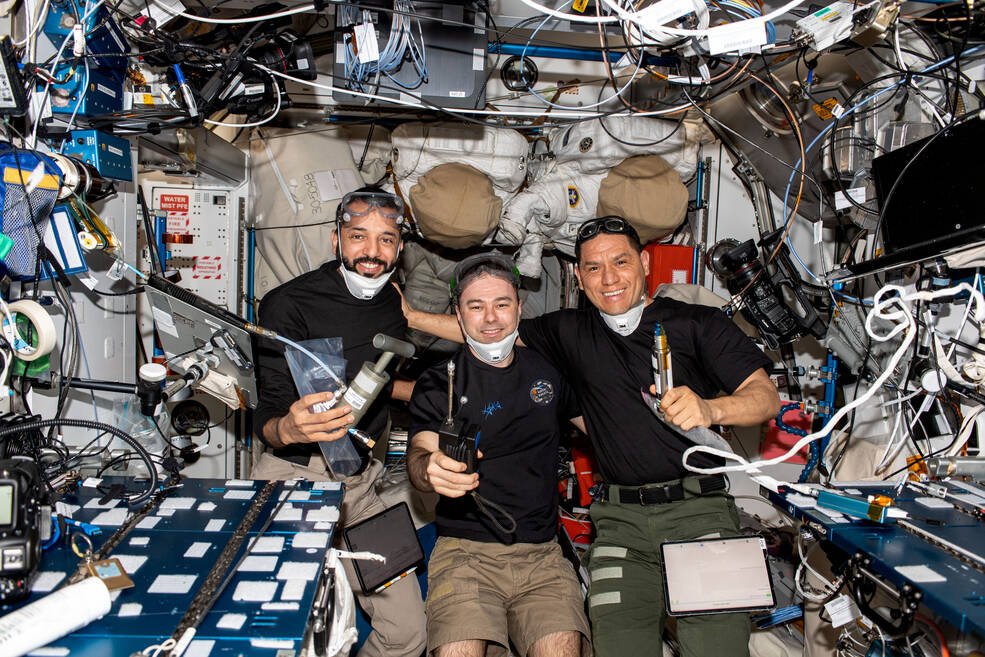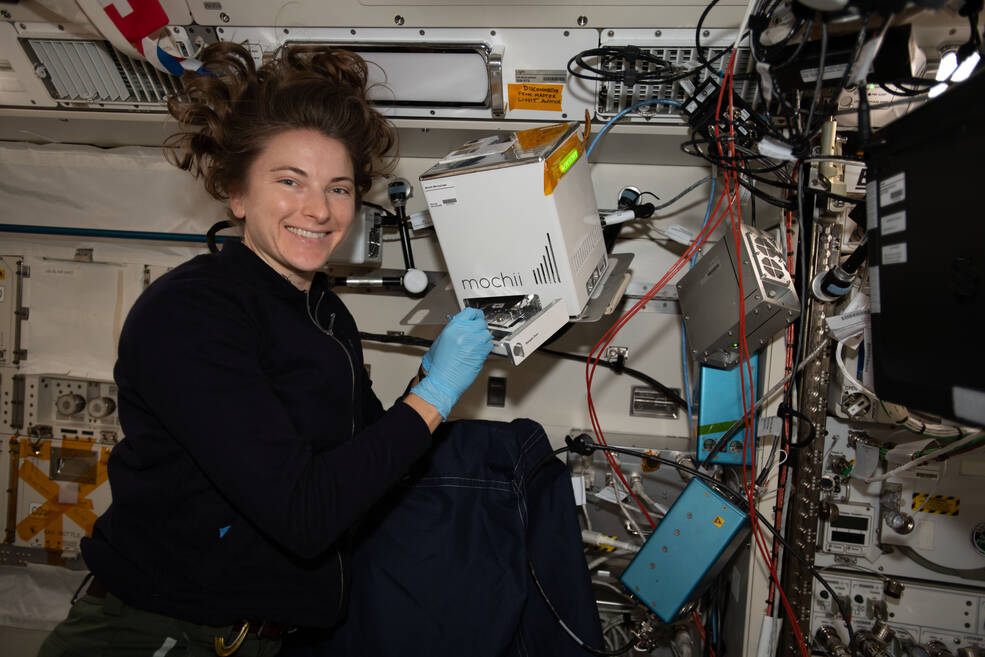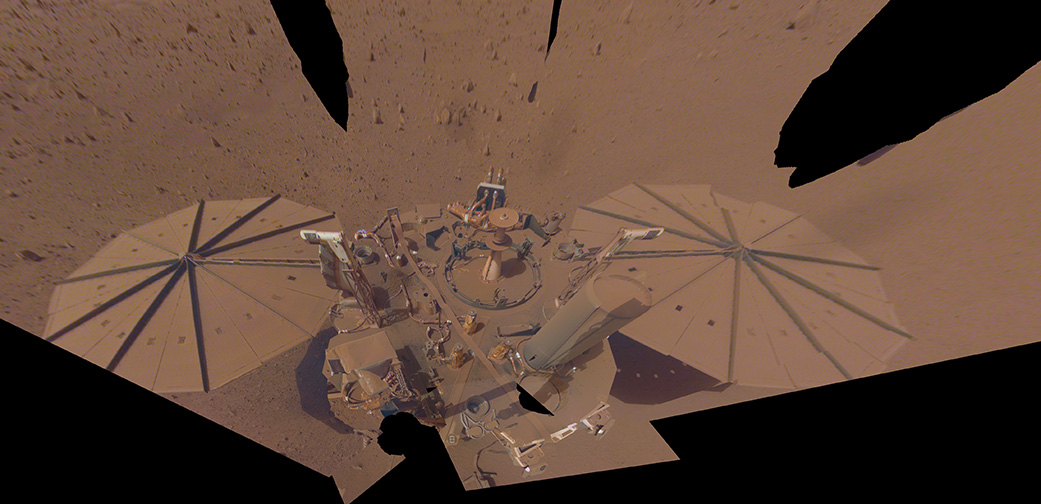The Marshall Star for August 9, 2023.
The Marshall Star: August 9, 2023
- Artemis II Crew Visits Their Ride Around the Moon
- Huge Solar Arrays Permanently Installed on NASA’s Psyche Spacecraft
- NASA’s Deep Space Communications to Get a Laser Boost
- Webb Spotlights Gravitational Arcs in ‘El Gordo’ Galaxy Cluster
- Science in Space: Spacecraft Air Quality
- InSight Study Finds Mars is Spinning Faster
- Artemis III Flight Hardware Featured on ‘This Week at NASA’
Artemis II Crew Visits Their Ride Around the Moon
Inside the high bay of the Neil Armstrong Operations and Checkout Building at NASA’s Kennedy Space Center, Artemis II NASA astronauts Reid Wiseman, Victor Glover, and Christina Koch, and CSA (Canadian Space Agency) astronaut Jeremy Hansen visit the Orion spacecraft Aug. 8 that will take them on a 10-day journey around the Moon as the first Artemis crew. The spacecraft is undergoing acoustic testing prior to integration with its service module, the next major step in the assembly process. Training is underway for the Artemis II astronauts in preparation for their lunar mission. The approximately 10-day Artemis II flight will test NASA’s foundational human deep space exploration capabilities, the SLS (Space Launch System) rocket and Orion spacecraft, for the first time with astronauts and will pave the way for lunar surface missions, including landing the first woman and first person of color on the Moon. (NASA/Kim Shiflett)
Huge Solar Arrays Permanently Installed on NASA’s Psyche Spacecraft
Robotically unfurling in a clean room near NASA’s Kennedy Space Center, the Psyche spacecraft’s jumbo solar arrays were tested and permanently installed on the orbiter in preparation for its 2.5 billion-mile journey to study a metal-rich asteroid. The launch period opens Oct. 5.
After passing the deployment test, the twin wings were re-stowed and will remain tucked away on the sides of the orbiter until the spacecraft leaves Earth. Psyche is scheduled to reach its destination – a mysterious asteroid of the same name, in the main asteroid belt between Mars and Jupiter – in July 2029. Then the spacecraft will orbit the asteroid from various altitudes for 26 months to gather images and other data.
Scientists hope that learning about the asteroid, which may be part of a core of a planetesimal (a building block of a planet), will tell us more about planetary cores and Earth’s own formation.
This final installation of the solar arrays took place at Astrotech Space Operations, near Kennedy. The arrays were deployed during testing last year at NASA’s Jet Propulsion Laboratory. At 800 square feet, the five-panel, cross-shaped solar arrays are the largest ever deployed at JPL. With the arrays unfurled in flight, the spacecraft will be about the size of a singles tennis court.
Although they will produce more than 20 kilowatts of power when the spacecraft is near Earth, the solar arrays are primarily designed to work in the low light of deep space. The asteroid Psyche is so far from the Sun that even these massive arrays will generate just over 2 kilowatts of power at that distance.
That’s only a little more power than a hair dryer uses but is ample energy to meet Psyche’s electrical needs, including running science instruments, telecommunications, equipment that controls the orbiter’s temperature, and the spacecraft’s superefficient solar electric propulsion engines. The system’s thrusters use electromagnetic fields to accelerate and push out charged atoms, or ions, of the neutral gas xenon. The expelled ions create the thrust that pushes Psyche through space and emit a blue glow.
This thrust is so gentle, it exerts about the same amount of pressure you’d feel holding the weight of one AA battery in your hand. But it’s enough to accelerate Psyche through deep space. With no atmospheric drag to hold it back, the spacecraft will accelerate to speeds of up to 124,000 mph relative to Earth during its interplanetary journey to the asteroid belt.
In mid-August, a crew is scheduled to begin loading all 2,392 pounds of xenon onto the spacecraft over the course of a couple weeks.
Watch as technicians at the Astrotech Space Operations facility deploy Psyche’s twin solar arrays – and permanently affix them to the spacecraft – one at a time. This timelapse video was shot over about eight days in late July.Credits: NASA/Glenn Benson and Cory Huston
A SpaceX Falcon Heavy is targeted to launch Psyche from Launch Complex 39A at Kennedy Space Center no earlier than 9:38 a.m. CDT on Oct. 5, with additional opportunities scheduled through Oct. 25.
Arizona State University leads the Psyche mission. A division of Caltech in Pasadena, JPL is responsible for the mission’s overall management, system engineering, integration and test, and mission operations. Maxar Technologies in Palo Alto, California, provided the high-power solar electric propulsion spacecraft chassis.
JPL also is providing a technology demonstration instrument called Deep Space Optical Communications that will fly on Psyche in order to test high-data-rate laser communications that could be used by future NASA missions.
Psyche is the 14th mission selected as part of NASA’s Discovery Program, managed by the agency’s Marshall Space Flight Center. NASA’s Launch Services Program, based at the Kennedy Space Center, is managing the launch service.
NASA’s Deep Space Communications to Get a Laser Boost
Set to launch this fall, NASA’s DSOC (Deep Space Optical Communications) project will test how lasers could speed up data transmission far beyond the capacity of current radio frequency systems used in space. What’s known as a technology demonstration, DSOC may pave the way for broadband communications that will help support humanity’s next giant leap: when NASA sends astronauts to Mars.
The DSOC near-infrared laser transceiver (a device that can send and receive data) will “piggyback” on NASA’s Psyche mission when it launches to a metal-rich asteroid of the same name in October. During the first two years of the journey, the transceiver will communicate with two ground stations in Southern California, testing highly sensitive detectors, powerful laser transmitters, and novel methods to decode signals the transceiver sends from deep space.
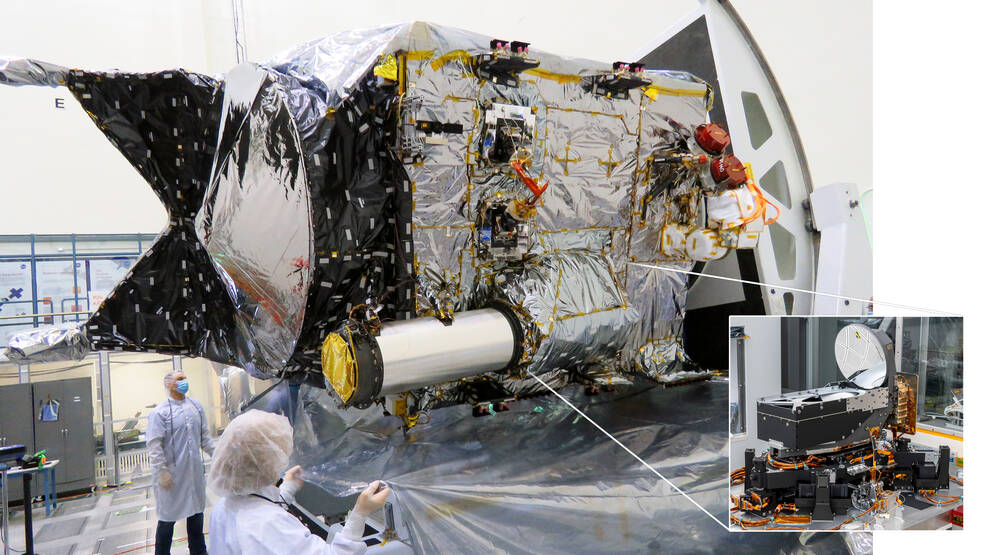
NASA is focused on laser, or optical, communication because of its potential to surpass the bandwidth of radio waves, which the space agency has relied on for more than half a century. Both radio and near-infrared laser communications use electromagnetic waves to transmit data, but near-infrared light packs the data into significantly tighter waves, enabling ground stations to receive more data at once.
“DSOC was designed to demonstrate 10 to 100 times the data-return capacity of state-of-the-art radio systems used in space today,” said Abi Biswas, DSOC’s project technologist at NASA’s Jet Propulsion Laboratory. “High-bandwidth laser communications for near-Earth orbit and for Moon-orbiting satellites have been proven, but deep space presents new challenges.”
There are more missions than ever headed for deep space, and they promise to produce exponentially more data than past missions in the form of complex science measurements, high-definition images, and video. So, experiments like DSOC will play a crucial role in helping NASA advance technologies that can be used routinely by spacecraft and ground systems in the future.
“DSOC represents the next phase of NASA’s plans for developing revolutionary improved communications technologies that have the capability to increase data transmissions from space – which is critical for the agency’s future ambitions,” said Trudy Kortes, director of the TDM (Technology Demonstrations Missions) program at NASA Headquarters. “We are thrilled to have the opportunity to test this technology during Psyche’s flight.”
Groundbreaking Technologies
The transceiver riding on Psyche features several new technologies, including a never-before-flown photon-counting camera attached to an 8.6-inch aperture telescope that protrudes from the side of the spacecraft. The transceiver will autonomously scan for, and “lock” onto, the high-power near-infrared laser uplink transmitted by the Optical Communication Telescope Laboratory at JPL’s Table Mountain Facility near Wrightwood, California. The laser uplink will also demonstrate sending commands to the transceiver.
“The powerful uplink laser is a critical part of this tech demo for higher rates to spacecraft, and upgrades to our ground systems will enable optical communications for future deep space missions,” said Jason Mitchell, program executive for NASA’s SCaN (Space Communications and Navigation) program at NASA Headquarters.
Once locked onto the uplink laser, the transceiver will locate the 200-inch Hale Telescope at Caltech’s Palomar Observatory in San Diego County, California, about 100 miles south of Table Mountain. The transceiver will then use its near-infrared laser to transmit high-rate data down to Palomar. Spacecraft vibrations that might otherwise nudge the laser off target will be dampened by state-of-the-art struts attaching the transceiver to Psyche.
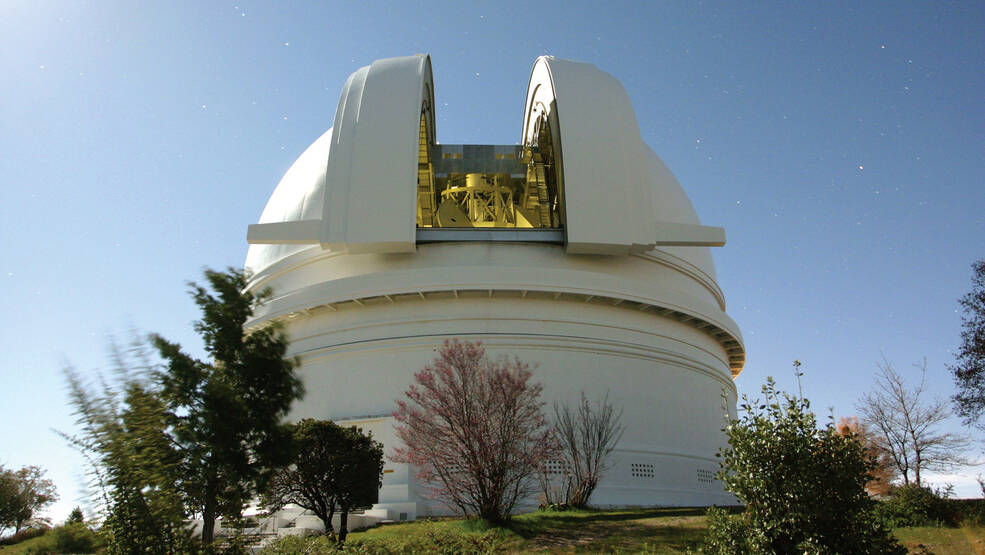
To receive the high-rate downlink laser from the DSOC transceiver, the Hale Telescope has been fitted with a novel superconducting nanowire single photon detector assembly. The assembly is cryogenically cooled so that a single incident laser photon (a quantum particle of light) can be detected and its arrival time recorded. Transmitted as a train of pulses, the laser light must travel more than 200 million miles (300 million kilometers) – the farthest the spacecraft will be during this tech demo – before the faint signals can be detected and processed to extract the information.
“Every component of DSOC exhibits new technology, from the high-power uplink lasers to the pointing system on the transceiver’s telescope and down to the exquisitely sensitive detectors that can count the single photons as they arrive,” said JPL’s Bill Klipstein, the DSOC project manager. “The team even needed to develop new signal-processing techniques to squeeze information out of such weak signals transmitted over vast distances.”
The distances involved pose another challenge for the tech demo: The farther Psyche journeys, the longer the photons will take to reach their destination, creating a lag of up to tens of minutes. The positions of Earth and the spacecraft will be constantly changing while the laser photons travel, so this lag will need to be compensated for.
“Pointing the laser and locking on over millions of miles while dealing with the relative motion of Earth and Psyche poses an exciting challenge for our project,” said Biswas.
More About the Mission
DSOC will demonstrate operations for nearly two years after NASA’s Psyche mission launch while en route to its Mars flyby in 2026. While the DSOC transceiver will be hosted by the Psyche spacecraft, the tech demo will not relay Psyche mission data. The success of each project is evaluated independently of the other.
DSOC is the latest in a series of optical communication demonstrations funded by TDM and SCaN. JPL, a division of Caltech in Pasadena, California, manages DSOC for TDM within NASA’s Space Technology Mission Directorate and SCaN within the agency’s Space Operations Mission Directorate. The Technology Demonstration Missions Program Office at NASA’s Marshall Space Flight Center is overseeing a portfolio of technology demonstration projects – both ground tests and flight tests – led by NASA centers and industry partners across the country.
The Psyche mission is led by Arizona State University. JPL is responsible for the mission’s overall management, system engineering, integration and test, and mission operations. Psyche is part of NASA’s Discovery Program, managed by Marshall.
Webb Spotlights Gravitational Arcs in ‘El Gordo’ Galaxy Cluster
A new image of the galaxy cluster known as “El Gordo” is revealing distant and dusty objects never seen before, and providing a bounty of fresh science. The infrared image, taken by NASA’s James Webb Space Telescope, displays a variety of unusual, distorted background galaxies that were only hinted at in previous Hubble Space Telescope images.
El Gordo is a cluster of hundreds of galaxies that existed when the universe was 6.2 billion years old, making it a “cosmic teenager.” It’s the most massive cluster known to exist at that time. (“El Gordo” is Spanish for the “Fat One.”)
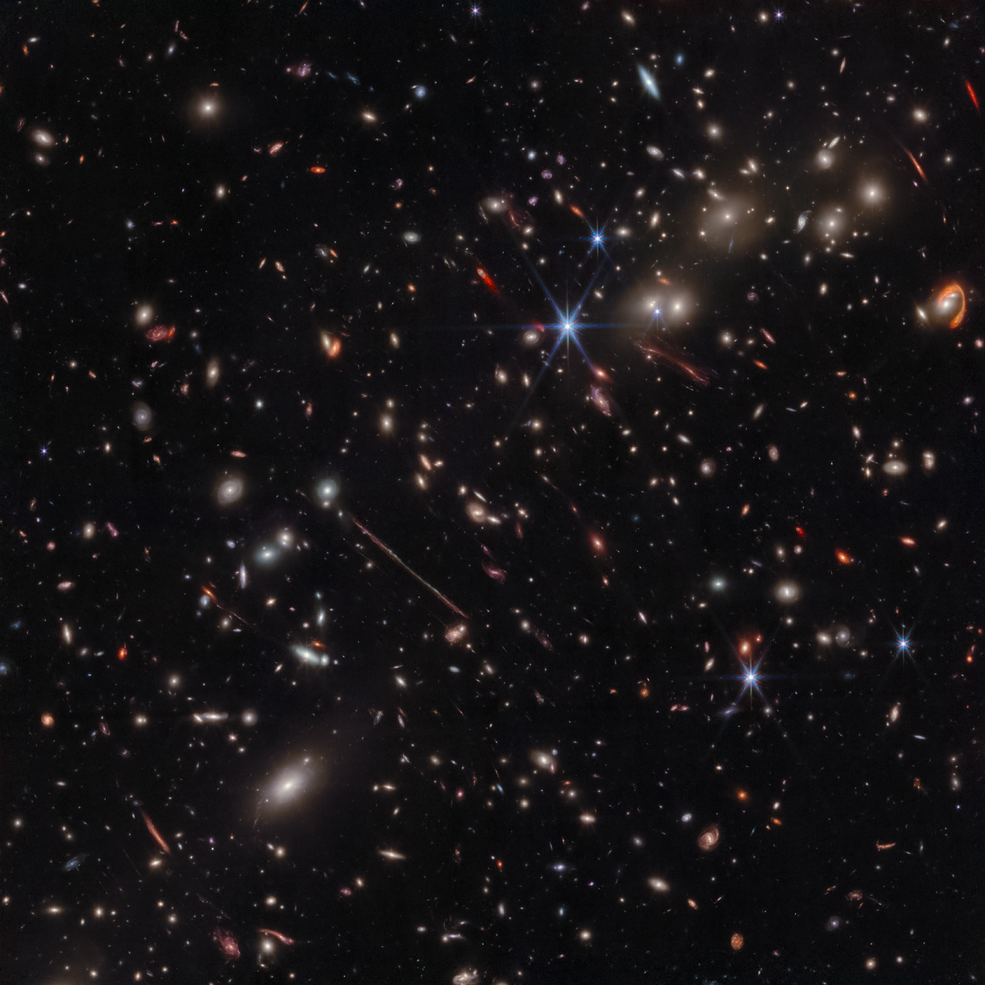
The team targeted El Gordo because it acts as a natural, cosmic magnifying glass through a phenomenon known as gravitational lensing. Its powerful gravity bends and distorts the light of objects lying behind it, much like an eyeglass lens.
“Lensing by El Gordo boosts the brightness and magnifies the sizes of distant galaxies. This lensing effect provides a unique window into the distant universe,” said Brenda Frye of the University of Arizona. Frye is co-lead of the PEARLS-Clusters branch of the PEARLS (Prime Extragalactic Areas for Reionization and Lensing Science) team and lead author of one of four papers analyzing the El Gordo observations.
The Fishhook
Within the image of El Gordo, one of the most striking features is a bright arc represented in red at upper right. Nicknamed “El Anzuelo” (The Fishhook) by one of Frye’s students, the light from this galaxy took 10.6 billion years to reach Earth. Its distinctive red color is due to a combination of reddening from dust within the galaxy itself and cosmological redshift due to its extreme distance.
By correcting for the distortions created by lensing, the team was able to determine that the background galaxy is disk-shaped but only 26,000 light-years in diameter – about one-fourth the size of the Milky Way. They also were able to study the galaxy’s star formation history, finding that star formation was already rapidly declining in the galaxy’s center, a process known as quenching.
“We were able to carefully dissect the shroud of dust that envelops the galaxy center where stars are actively forming,” said Patrick Kamieneski of Arizona State University, lead author on a second paper. “Now, with Webb, we can peer through this thick curtain of dust with ease, allowing us to see firsthand the assembly of galaxies from the inside out.”
The Thin One
Another prominent feature in the Webb image is a long, pencil-thin line at left of center. Known as “La Flaca” (the Thin One), it is another lensed background galaxy whose light also took nearly 11 billion years to reach Earth.
Not far from La Flaca is another lensed galaxy. When the researchers examined that galaxy closely, they found a single red giant star that they nicknamed Quyllur, which is the Quechua term for star.
Previously, Hubble has found other lensed stars (such as Earendel), but they were all blue supergiants. Quyllur is the first individual red giant star observed beyond 1 billion light-years from Earth. Such stars at high redshift are only detectable using the infrared filters and sensitivity of Webb.
“It’s almost impossible to see lensed red giant stars unless you go into the infrared. This is the first one we’ve found with Webb, but we expect there will be many more to come,” said Jose Diego of the Instituto de Física de Cantabria in Spain, lead author of a third paper on El Gordo.
Galaxy Group and Smudges
Other objects within the Webb image, while less prominent, are equally interesting scientifically. For example, Frye and her team (which includes nine students from high school to graduate students) identified five multiply lensed galaxies which appear to be a baby galaxy cluster forming about 12.1 billion years ago. There are another dozen candidate galaxies which may also be part of this distant cluster.
“While additional data are required to confirm that there are 17 members of this cluster, we may be witnessing a new galaxy cluster forming right before our eyes, just over a billion years after the big bang,” said Frye.
A final paper examines very faint, smudge-like galaxies known as ultra-diffuse galaxies. As their name suggests, these objects, which are scattered throughout the El Gordo cluster, have their stars widely spread out across space. The team identified some of the most distant ultra-diffuse galaxies ever observed, whose light traveled 7.2 billion years to reach us.
“We examined whether the properties of these galaxies are any different than the ultra-diffuse galaxies we see in the local universe, and we do actually see some differences. In particular, they are bluer, younger, more extended, and more evenly distributed throughout the cluster. This suggests that living in the cluster environment for the past 6 billion years has had a significant effect on these galaxies,” explained Timothy Carleton of Arizona State University, lead author on the fourth paper.
“Gravitational lensing was predicted by Albert Einstein more than 100 years ago. In the El Gordo cluster, we see the power of gravitational lensing in action,” concluded Rogier Windhorst of Arizona State University, principal investigator of the PEARLS program. “The PEARLS images of El Gordo are out-of-this-world beautiful. And, they have shown us how Webb can unlock Einstein’s treasure chest.”
The paper by Frye et al. has been published in the Astrophysical Journal. The paper by Kamieneski et al. has been accepted for publication in the Astrophysical Journal. The paper by Diego et al. has been published in Astronomy & Astrophysics. The paper by Carleton et al. has been accepted for publication in the Astrophysical Journal.
The James Webb Space Telescope is the world’s premier space science observatory. Webb is solving mysteries in our solar system, looking beyond to distant worlds around other stars, and probing the mysterious structures and origins of our universe and our place in it. Webb is an international program led by NASA with its partners, ESA (European Space Agency) and the Canadian Space Agency. Several NASA centers contributed to the project, including NASA’s Marshall Space Flight Center.
Science in Space: Spacecraft Air Quality
Crew members aboard the International Space Station conducted a variety of scientific investigations during the week ending Aug. 4, including collecting samples for ANITA-2.
Monitoring and maintaining the quality of the air inside the space station is essential to ensure crew health and comfort and proper functioning of equipment. These activities become more important as mission duration increases. ANITA-2, an investigation from ESA (European Space Agency), uses a compact gas analyzer to automatically monitor 33 trace contaminants in the station’s ambient air. The device also can detect unknown substances that can be analyzed later on the ground. ESA confirmed the type of spectroscopy the instrument uses as the best technology for continuous monitoring of cabin air and tested the effectiveness of its operation.
Another issue in spacecraft air is suspended particles, also known as aerosols, inside a spacecraft. Sources of aerosols include lint from clothing, sweat droplets from crew members, particles from personal care and cleaning products, and particles from use of equipment such as laser printers and exercise devices. The Airborne Particulate Monitor demonstrates an instrument for measuring and quantifying the concentration of particles in spacecraft air. The data shed light on the sources of such particles and show whether current filtration systems are working properly.
Returning particle samples to Earth for analysis creates delays that can leave the crew and vehicle at risk. Mochii is a miniature scanning electron microscope that measures particles on the space station in real time, a critical need for future missions that go deeper into space where sending back samples is not possible. Researchers verified the performance of Mochii on the space station by analyzing a Martian meteorite previously analyzed on the ground.
Trace gases also represent a potential problem in cabin air. Four Bed CO2 Scrubber demonstrates a technology that upgrades the current system for removing carbon dioxide (CO2) from the atmosphere on the space station. The system operated reliably and used less power than current systems, but its mass still needs to be reduced for use on future missions. The space station provides a crucial platform for testing such systems.
The Thermal Amine Scrubber investigation also tests a method to remove carbon dioxide from station air using actively heated and cooled beds of amine, an organic compound derived from ammonia. JAXA (Japan Aerospace Exploration Agency) is testing a carbon dioxide removal system on the space station that uses both sorbents, materials that absorb liquids or gasses, and desiccants, materials that remove moisture from the air. Controlling carbon dioxide levels helps protect crew members from symptoms of buildup of the gas, which include fatigue, headache, breathing difficulties, strained eyes, and itchy skin.
An ongoing investigation, OGA H2 Sensor Demo, tests new hydrogen sensors for the space station’s oxygen generation system (OGS). The OGS produces breathable oxygen via electrolysis – separating water into oxygen and hydrogen. The hydrogen is vented overboard or sent to a processor and recombined with waste carbon dioxide to produce water. The sensors currently used to ensure that no hydrogen enters the cabin air are sensitive to humidity and can become less precise over time. The new sensors are expected to be more stable and may be integrated into an advanced OGA for future exploration missions.
Spacecraft Atmosphere Monitor demonstrates a small device to measure trace volatile organic compounds in cabin air. The instrument continuously transmits data back to the ground research team for analysis.
This research helps ensure that crew members have safe and adequate air to breathe, and that poor air quality does not affect the function of equipment. The monitoring technology used on the space station also has applications for environmental and air quality monitoring in closed environments on Earth.
The Payload Operations Integration Center at NASA’s Marshall Space Flight Center operates, plans, and coordinates the science experiments onboard the space station 365 days a year, 24 hours a day.
Learn more about the space station.
InSight Study Finds Mars is Spinning Faster
Scientists have made the most precise measurements ever of Mars’ rotation, for the first time detecting how the planet wobbles due to the “sloshing” of its molten metal core. The findings, detailed in a recent Nature paper, rely on data from NASA’s InSight Mars lander, which operated for four years before running out of power during its extended mission in December 2022.
To track the planet’s spin rate, the study’s authors relied on one of InSight’s instruments: a radio transponder and antennas collectively called the Rotation and Interior Structure Experiment, or RISE. They found the planet’s rotation is accelerating by about 4 milliarcseconds per year – corresponding to a shortening of the length of the Martian day by a fraction of a millisecond per year.
It’s a subtle acceleration, and scientists aren’t entirely sure of the cause. But they have a few ideas, including ice accumulating on the polar caps or post-glacial rebound, where landmasses rise after being buried by ice. The shift in a planet’s mass can cause it to accelerate a bit like an ice skater spinning with their arms stretched out, then pulling their arms in.
“It’s really cool to be able to get this latest measurement – and so precisely,” said InSight’s principal investigator, Bruce Banerdt of NASA’s Jet Propulsion Laboratory. “I’ve been involved in efforts to get a geophysical station like InSight onto Mars for a long time, and results like this make all those decades of work worth it.”
RISE is part of a long tradition of Mars landers using radio waves for science, including the twin Viking landers in the 1970s and the Pathfinder lander in the late ’90s. But none of those missions had the advantage of InSight’s advanced radio technology and upgrades to the antennas within NASA’s Deep Space Network on Earth. Together, these enhancements provided data about five times more accurate than what was available for the Viking landers.
In the case of InSight, scientists would beam a radio signal to the lander using the Deep Space Network. RISE would then reflect the signal back. When scientists received the reflected signal, they would look for tiny changes in frequency caused by the Doppler shift (the same effect that causes an ambulance siren to change pitch as it gets closer and farther away). Measuring the shift enabled researchers to determine how fast the planet rotates.
“What we’re looking for are variations that are just a few tens of centimeters over the course of a Martian year,” said the paper’s lead author and RISE’s principal investigator, Sebastien Le Maistre at the Royal Observatory of Belgium. “It takes a very long time and a lot of data to accumulate before we can even see these variations.”
The paper examined data from InSight’s first 900 Martian days – enough time to look for such variations. Scientists had their work cut out for them to eliminate sources of noise: Water slows radio signals, so moisture in the Earth’s atmosphere can distort the signal coming back from Mars. So can the solar wind, the electrons and protons flung into deep space from the Sun.
“It’s a historic experiment,” said Le Maistre. “We have spent a lot of time and energy preparing for the experiment and anticipating these discoveries. But despite this, we were still surprised along the way – and it’s not over, since RISE still has a lot to reveal about Mars.”
RISE data was also used by the study authors to measure Mars’ wobble – called its nutation – due to sloshing in its liquid core. The measurement allows scientists to determine the size of the core: Based on RISE data, the core has a radius of roughly 1,140 miles.
The authors then compared that figure with two previous measurements of the core derived the from spacecraft’s seismometer. Specifically, they looked at how seismic waves traveled through the planet’s interior – whether they reflected off the core or passed through it unimpeded.
Taking all three measurements into account, they estimate the core’s radius to be between 1,112 and 1,150 miles. Mars as a whole has a radius of 2,106 miles – about half the size of Earth’s.
Measuring Mars wobble also provided details about the shape of the core.
“RISE’s data indicate the core’s shape cannot be explained by its rotation alone,” said the paper’s second author, Attilio Rivoldini of the Royal Observatory of Belgium. “That shape requires regions of slightly higher or lower density buried deep within the mantle.”
While scientists will be mining InSight data for years to come, this study marks the final chapter for Banerdt’s role as the mission’s principal investigator. After 46 years with JPL, he retired on Aug. 1.
JPL managed InSight for NASA’s Science Mission Directorate. InSight was part of NASA’s Discovery Program, managed by the agency’s Marshall Space Flight Center. Lockheed Martin Space in Denver built the InSight spacecraft, including its cruise stage and lander, and supports spacecraft operations for the mission.
A number of European partners, including France’s CNES (Centre National d’Études Spatiales) and the German Aerospace Center, are supporting the InSight mission. CNES provided the Seismic Experiment for Interior Structure instrument to NASA, with the principal investigator at IPGP (Institut de Physique du Globe de Paris).
Artemis III Flight Hardware Featured on ‘This Week at NASA’
Teams at United Launch Alliance’s Decatur, Alabama, facility recently packed up NASA’s SLS (Space Launch System) rocket’s interim cryogenic propulsion stage for Artemis III. The activity is featured in “This Week @ NASA,” a weekly video program broadcast on NASA-TV and posted online.
The flight hardware, sometimes referred to as the ICPS for short, was being prepped for a trip to ULA’s facility near NASA’s Kennedy Space Center for final checkouts. During the Artemis III mission, the ICPS will provide in-space propulsion to send astronauts inside our Orion spacecraft to the Moon. The SLS Program is managed by NASA’s Marshall Space Flight Center.
View this and previous episodes at “This Week @NASA” on NASA’s YouTube page.


























